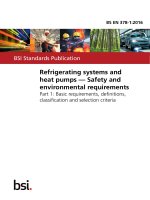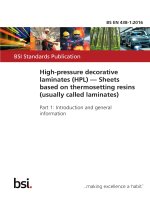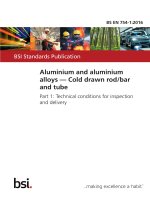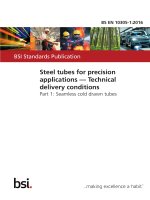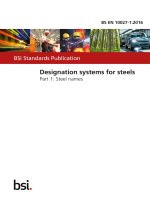Bsi bs en 15681 1 2016
Bạn đang xem bản rút gọn của tài liệu. Xem và tải ngay bản đầy đủ của tài liệu tại đây (1.05 MB, 22 trang )
BS EN 15681-1:2016
BSI Standards Publication
Glass in building — Basic
alumino silicate glass products
Part 1: Definitions and general physical and
mechanical properties
BS EN 15681-1:2016
BRITISH STANDARD
National foreword
This British Standard is the UK implementation of EN 15681-1:2016.
The UK participation in its preparation was entrusted to Technical
Committee B/520/1, Basic and transformed glass products.
A list of organizations represented on this committee can be
obtained on request to its secretary.
This publication does not purport to include all the necessary
provisions of a contract. Users are responsible for its correct
application.
© The British Standards Institution 2016.
Published by BSI Standards Limited 2016
ISBN 978 0 580 89846 4
ICS 81.040.20
Compliance with a British Standard cannot confer immunity from
legal obligations.
This British Standard was published under the authority of the
Standards Policy and Strategy Committee on 29 February 2016.
Amendments/corrigenda issued since publication
Date
Text affected
BS EN 15681-1:2016
EN 15681-1
EUROPEAN STANDARD
NORME EUROPÉENNE
EUROPÄISCHE NORM
January 2016
ICS 81.040.20
English Version
Glass in building - Basic alumino silicate glass products Part 1: Definitions and general physical and mechanical
properties
Verre dans la construction - Produits de base : verre
aluminosilicate - Partie 1 : Définitions et propriétés
physiques et mécaniques générales
Glas im Bauwesen - Basiserzeugnisse aus AlumoSilicatglas - Teil 1: Definitionen und allgemeine
physikalische und mechanische Eigenschaften
This European Standard was approved by CEN on 30 November 2015.
CEN members are bound to comply with the CEN/CENELEC Internal Regulations which stipulate the conditions for giving this
European Standard the status of a national standard without any alteration. Up-to-date lists and bibliographical references
concerning such national standards may be obtained on application to the CEN-CENELEC Management Centre or to any CEN
member.
This European Standard exists in three official versions (English, French, German). A version in any other language made by
translation under the responsibility of a CEN member into its own language and notified to the CEN-CENELEC Management
Centre has the same status as the official versions.
CEN members are the national standards bodies of Austria, Belgium, Bulgaria, Croatia, Cyprus, Czech Republic, Denmark, Estonia,
Finland, Former Yugoslav Republic of Macedonia, France, Germany, Greece, Hungary, Iceland, Ireland, Italy, Latvia, Lithuania,
Luxembourg, Malta, Netherlands, Norway, Poland, Portugal, Romania, Slovakia, Slovenia, Spain, Sweden, Switzerland, Turkey and
United Kingdom.
EUROPEAN COMMITTEE FOR STANDARDIZATION
COMITÉ EUROPÉEN DE NORMALISATION
EUROPÄISCHES KOMITEE FÜR NORMUNG
CEN-CENELEC Management Centre: Avenue Marnix 17, B-1000 Brussels
© 2016 CEN
All rights of exploitation in any form and by any means reserved
worldwide for CEN national Members.
Ref. No. EN 15681-1:2016 E
BS EN 15681-1:2016
EN 15681-1:2016 (E)
Contents
Page
European foreword....................................................................................................................................................... 3
1
Scope .................................................................................................................................................................... 4
2
Normative references .................................................................................................................................... 4
3
Terms and definitions ................................................................................................................................... 4
4
4.1
4.2
Chemical composition ................................................................................................................................... 6
General ................................................................................................................................................................ 6
Tint ....................................................................................................................................................................... 6
5
5.1
5.2
5.3
5.3.1
5.3.2
5.3.3
5.4
Physical and mechanical characteristics ................................................................................................ 6
General characteristics ................................................................................................................................. 6
Characteristic bending strength ................................................................................................................ 7
Designation of clear alumino silicate glass ............................................................................................ 7
General ................................................................................................................................................................ 7
Clear transparent alumino silicate glass ................................................................................................ 8
Clear translucent alumino silicate glass ................................................................................................. 8
Stability of physical and chemical characteristics .............................................................................. 9
6
6.1
6.1.1
6.1.2
6.2
6.3
Dimensional requirements.......................................................................................................................... 9
Manufacturing dimensions .......................................................................................................................... 9
Stock sizes .......................................................................................................................................................... 9
Supplied and final cut sizes ......................................................................................................................... 9
Thickness and thickness tolerances......................................................................................................... 9
Length, width and squareness ................................................................................................................. 10
7
7.1
7.2
7.2.1
7.2.2
7.4
7.4.1
7.4.2
7.4.3
Quality requirements ................................................................................................................................. 10
General ............................................................................................................................................................. 10
Methods of observation and measurement ........................................................................................ 11
Optical faults .................................................................................................................................................. 11
Visual faults (spot faults, linear/extended faults), all types of basic alumino silicate
glass ................................................................................................................................................................... 12
Acceptance levels ......................................................................................................................................... 13
Optical faults .................................................................................................................................................. 13
Visual faults (spot faults, linear/extended faults), all types of basic alumino silicate
glass ................................................................................................................................................................... 13
Edge defects for final cut sizes ................................................................................................................. 14
Entrant and emergent faults .................................................................................................................... 14
Bevel ................................................................................................................................................................. 14
Limitations on edge defects ...................................................................................................................... 14
8
Designation..................................................................................................................................................... 15
7.3
7.3.1
7.3.2
Annex A (informative) Complementary information related to REACH ................................................. 16
Bibliography ................................................................................................................................................................. 17
2
BS EN 15681-1:2016
EN 15681-1:2016 (E)
European foreword
This document (EN 15681-1:2016) has been prepared by Technical Committee CEN/TC 129 “Glass in
building”, the secretariat of which is held by NBN.
This European Standard shall be given the status of a national standard, either by publication of an
identical text or by endorsement, at the latest by July 2016, and conflicting national standards shall be
withdrawn at the latest by July 2016.
Attention is drawn to the possibility that some of the elements of this document may be the subject of
patent rights. CEN [and/or CENELEC] shall not be held responsible for identifying any or all such patent
rights.
This document has been prepared under a mandate given to CEN by the European Commission and the
European Free Trade Association.
This European Standard consists of the following parts:
— EN 15681-1 Glass in Building — Basic alumino silicate glass products — Part 1: Definitions and
general physical and mechanical properties;
— EN 15681-2 Glass in Building — Basic alumino silicate glass products — Part 2: Evaluation of
conformity / Product standard 1.
According to the CEN-CENELEC Internal Regulations, the national standards organizations of the
following countries are bound to implement this European Standard: Austria, Belgium, Bulgaria,
Croatia, Cyprus, Czech Republic, Denmark, Estonia, Finland, Former Yugoslav Republic of Macedonia,
France, Germany, Greece, Hungary, Iceland, Ireland, Italy, Latvia, Lithuania, Luxembourg, Malta,
Netherlands, Norway, Poland, Portugal, Romania, Slovakia, Slovenia, Spain, Sweden, Switzerland,
Turkey and the United Kingdom.
1 Standard under development.
3
BS EN 15681-1:2016
EN 15681-1:2016 (E)
1 Scope
This Part of this European Standard specifies and classifies basic alumino silicate glass products,
indicates their chemical composition, their main physical and mechanical characteristics, their
dimensional and their minimum quality requirements (in respect of optical and visual faults).
This European Standard applies to basic alumino silicate glasses supplied in stock sizes, supplied sizes
or in cut sizes for final end use.
This European Standard does not apply to final cut sizes having a dimension less than 100 mm or a
surface area less than 0,05 m2.
2 Normative references
The following documents, in whole or in part, are normatively referenced in this document and are
indispensable for its application. For dated references, only the edition cited applies. For undated
references, the latest edition of the referenced document (including any amendments) applies.
EN 410, Glass in building - Determination of luminous and solar characteristics of glazing
ISO 9385, Glass and glass-ceramics — Knoop hardness test
3 Terms and definitions
For the purposes of this document, the following terms and definitions apply.
3.1
alumino silicate glass
silicate glass containing between 5,8 % to 16,2 % aluminium and with a chemical composition
according to 4.1 of this standard
3.2
alumino silicate float glass
flat, transparent, clear or tinted alumino silicate glass having parallel and polished faces obtained by
continuous casting and floatation on a metal bath
Note 1 to entry:
In French called 'glace' and in German 'Floatglas'.
3.3
alumino silicate drawn sheet glass
flat, transparent or translucent, clear or tinted basic alumino silicate glass obtained by continuous
drawing of a regular thickness and with the two surfaces fire polished
3.4
alumino silicate rolled glass
flat, transparent or translucent, clear or tinted basic alumino silicate glass obtained by rolling
3.5
length, H and width, B
defined with reference to the direction of draw of the glass ribbon as shown in Figure 1
4
BS EN 15681-1:2016
EN 15681-1:2016 (E)
Key
I
H
B
direction of draw
length
width
Figure 1 — Relationship between length, width and direction of draw
3.6
stock sizes
glass delivered in manufacturers standard stock sizes
3.7
supplied size
pane of glass that has been supplied either as raw material for further processing and/or cutting down
to a size for installation
Note 1 to entry:
This is a size that is outside the stock size.
3.8
final cut size
pane of glass that has been cut down to the dimensions being required either for installation or
processing into a final product
Note 1 to entry: Examples of processed final products are insulating glass units and thermally toughened safety
glass of those dimensions.
3.9
optical fault
fault which leads to distortions in the appearance of objects observed through the glass
3.10
visual fault
fault which alters the visual quality of the glass
Note 1 to entry:
Visual faults include spot faults and linear / extended faults.
3.11
spot fault
spherical or quasi spherical fault which is produced by differing mechanisms, e.g. gaseous inclusion,
solid inclusion, mark or deposit of small size
3.12
linear / extended faults
fault which can be on or in the glass, in the form of deposits, reams, marks or scratches that occupy an
extended length or area
5
BS EN 15681-1:2016
EN 15681-1:2016 (E)
3.13
edge defect
defect which can occur on the edge of a cut size piece in the form of entrant and emergent fault and/or
bevel
3.14
concentration
sum of the lengths of gaseous inclusions greater than 1,0 mm in any circle of 400 mm diameter
4 Chemical composition
4.1 General
The basic glass products covered by this European Standard are all manufactured from alumino silicate
glass.
The magnitude of the proportions by mass of the constituents of alumino silicate glass covered by this
standard is given in Table 1, see also Annex A
Table 1 — Magnitude of the proportions by mass of the constituents of alumino silicate glass
Constituents
Proportion by mass
of element
Silicon (Si)
25,3 % to 35,1 %
Σ Si + Al
32,1 % to 51,3 %
Aluminium (Al)
Lithium (Li)
Sodium (Na)
Calcium (Ca)
Magnesium (Mg)
0 % to 3,7 %
0 % to 10,5 %
0 % to 2,1 %
0 % to 5 %
Zinc (Zn)
0 % to 2,4 %
Zirconium (Zr)
0 % to 3,0 %
Barium (Ba)
0 % to 3,6 %
Potassium (K)
Strontium (Sr)
Other componentsa
4.2 Tint
5,8 % to 16,2 %
a
0 % to 7 %
0 % to 2,5 %
0 % to 5 %
Properties other than photometric characteristics shall
not be significantly altered by these other components
Body tinted glass is obtained by the addition of suitable materials.
5 Physical and mechanical characteristics
5.1 General characteristics
Conventional numerical values for the physical and mechanical characteristics of basic alumino silicate
glass products excluding ‘Characteristic bending strength’ (fg;k) are given in Table 2. These values, for
6
BS EN 15681-1:2016
EN 15681-1:2016 (E)
normal annealed glass without any further toughening, are not precise requirements with which the
glass shall strictly comply, but are the generally accepted figures for use in calculations where a high
degree of accuracy is not required.
Table 2 — General characteristic values of basic alumino silicate glass
Characteristic
Symbol
Value and unit
Density (at 18 °C)
ρ
2300 to 2600 kg/m3
Young's modulus (modulus of elasticity)
E
Hardness (Knoop)
HK0,1/20
Poisson's ratio
μ
70 to 90 x GPa
Nominal value of average coefficient of linear expansion between 20 °C and
300 °C
Cp
α
0,7 to 0,9 × 103 J/(kg*K)
Resistance against temperature differential and sudden temperature change
Thermal conductivity
λ
60 K b
Mean refractive index to visible radiation (at 589,3 nm)
Emissivity (corrected)
n
ε
1,5 to 1,55
Specific heat capacity
a
b
Knoop Hardness in accordance with ISO 9385
400 to 700 a
0,2 to 0,25
3,5 to 9,8 × 10−6/K
0,8 to 1,7 W/(m*K)
0,837
Generally accepted value that is influenced by edge quality and glass type
5.2 Characteristic bending strength
The characteristic bending strength value applies to quasi-static loading over a short time, e.g. wind
loading, and relate to a 5 % probability of breakage at the lower limit of the 95 % confidence interval.
The value of the characteristic bending strength, fg;k, for alumino silicate float glass is 45 MPa, for drawn
sheet and rolled glass 25 MPa.
NOTE
Methods of determination of the bending strength of glass are given in EN 1288–1, EN 1288–2,
EN 1288–3, EN 1288–4 and EN 1288–5 (see [1], [2], [3], [4], [5]). Design of glass panes is covered by prEN 16612
(see [6]).
5.3 Designation of clear alumino silicate glass
5.3.1 General
An alumino silicate glass product is designated as clear alumino silicate glass when it is not tinted and
when the light transmittance of the glass material, unmodified by the possible presence of a coating or
surface roughness complies with 5.3.2 and 5.3.3.
In order to measure the light transmittance characteristics of glass, to determine whether it can be
designated as a clear glass, it is necessary, in some cases, to carry out a pre-treatment:
— coatings on smooth surfaces have to be eliminated, without modifying the thickness of the glass
substrate;
— rough surfaces, with or without coatings, have to be eliminated by smoothing and polishing. The
thickness of the glass will be modified by this process.
The light transmittance of the glass substrate shall be measured with its surfaces in a polished
condition.
7
BS EN 15681-1:2016
EN 15681-1:2016 (E)
NOTE
The light transmittance values given in 5.3.2 and 5.3.3 are not suitable for design. They are values used
only for the designation of clear glass and exclude the effects of coatings and of surface roughness. The values of
light transmittance used for design can be obtained from the glass manufacturer. They are determined in
accordance with EN 410.
5.3.2 Clear transparent alumino silicate glass
A transparent glass product shall be designated as clear glass when it is not tinted and when its light
transmittance:
— after any necessary pre-treatment,
— measured according to EN 410 and
— rounded to the nearest 0,01
is greater than or equal to the value given in Table 3 for the nominal thickness of the glass product.
NOTE
The limiting value given in Table 3 is appropriate provided that the measured thickness of the glass
product is within the allowable tolerances for the nominal thickness of that glass product.
Table 3 — Minimum light transmittance values for designating a transparent glass product as
clear
Nominal thickness (mm)
Minimum value
2-5
0,87
10, 12
0,80
6, 8
15
19
25
5.3.3 Clear translucent alumino silicate glass
0,84
0,77
0,73
0,68
A translucent glass product is designated as clear glass when it is not tinted and when its light
transmittance:
— after any necessary pre-treatment;
— measured according to EN 410; and
— rounded to the nearest 0,01;
is greater than or equal to the value obtained by linear interpolation from Table 4, for the measured
thickness of the specimen.
NOTE
8
The limiting value will vary with the exact thickness of the specimen after its pre-treatment.
BS EN 15681-1:2016
EN 15681-1:2016 (E)
Table 4 — Minimum light transmittance values for designating a translucent glass product as
clear
Nominal thickness (mm)
Minimum value
2-5
0,81
10, 12
0,74
6, 8
15
19
25
5.4 Stability of physical and chemical characteristics
0,78
0,71
0,67
0,62
For basic alumino silicate glass products, the physical and chemical characteristics can be considered as
remaining constant over time.
a) Since glass is insensitive to photochemical effects, the spectral properties (transmissions of light
and solar energy) of the basic glass products are not modified significantly by direct or indirect
solar radiation.
b) The surface of glass used in building is virtually insensitive to attack from the environment.
NOTE
While the surface of the glass when installed in a building is virtually insensitive to attack from water,
it is advised to take care to protect the glass surface prior to installation. Inappropriate storage can result in
water/humidity being drawn up between glass sheets. This concentrated environment can cause attack of the
surface (see [7]).
6 Dimensional requirements
6.1 Manufacturing dimensions
6.1.1 Stock sizes
Glass delivered in the following size range:
Nominal length
Nominal width
H:
B:
2000 mm to 6000 mm
1000 mm to 3210 mm
6.1.2 Supplied and final cut sizes
Glass delivered in any dimension less than those covered by the stock sizes.
The minimum cut size shall have dimensions H and B not less than 100 mm and a minimum surface
area of not less than 0,05 m2.
6.2 Thickness and thickness tolerances
The actual thickness shall be the average of four measurements, taken to the nearest 0,01 mm, one
taken at the centre of each side. Measurement shall be made by means of an instrument of the calliper
micrometre type.
The actual thickness, rounded to the nearest 0,1 mm shall not vary from the nominal thickness by more
than the tolerances shown in Table 5.
9
BS EN 15681-1:2016
EN 15681-1:2016 (E)
Table 5 — Nominal thicknesses and thickness tolerances
Thickness tolerances for glass type
Nominal thickness
D (mm)
Float
Drawn sheet, rolled
2
±0,2
±0,5
4
±0,2
±0,5
3
±0,2
5
±0,5
±0,2
6
±0,5
±0,2
8
±0,5
±0,3
10
±0,8
±0,3
12
±1,0
±0,3
15
±1,5
±0,5
19
±1,5
±1,0
25
±2,0
±1,0
6.3 Length, width and squareness
±2,5
The tolerances, t, on nominal dimensions length, H and width, B are given in Table 6.
Table 6 — Tolerances, t, on the nominal dimensions length and width
Nominal thickness, d
(mm)
Tolerance t (mm)
Stock
Supplied and final cut sizes
(H, B) ≤ 1500
1500 < (H,B) ≤ 3000
(H, B) > 3000
2-6
±10
±2
±5
±8
15, 19, 25
±10
±4
±5
±8
8 - 12
±10
±3
±5
±8
The limits of squareness are described by the difference between diagonals. Limits are given in Table 7.
Table 7 — Limits for the difference between diagonals
Nominal thickness,
d (mm)
Limit for the difference between diagonals (mm)
Stock
Supplied and final cut sizes
(H, B) ≤ 1500
1500 < (H, B) ≤ 3000
(H, B) > 3000
2-6
10
3
4
5
15, 19, 25
10
5
6
8
8 - 12
10
7 Quality requirements
4
5
6
7.1 General
Alumino silicate glass is classified into three categories, A, B and C, according to optical faults and visual
faults (see 7.3).
NOTE
10
It is advised to consult the manufacturer(s) if higher levels of quality are required.
BS EN 15681-1:2016
EN 15681-1:2016 (E)
7.2 Methods of observation and measurement
7.2.1 Optical faults
7.2.1.1 Method of observation of optical faults on float glass
A screen bearing an assembly of black and white stripes (zebra) is observed through the glass to be
examined.
The usual size of screen is between 1500 mm x 1150 mm and 2500 mm x 2000 mm. It consists of a
translucent white background with parallel black stripes, 25 mm wide and 25 mm apart, inclined at 45°.
The screen is uniformly lit from behind with white daylight fluorescent tubes. The illuminance of the
screen measured 1 m from it shall be between 400 lx and 1 200 lx. The measurement shall be taken at a
point on a line normal to the centre of the screen. The walls of the test room should be painted with a
dark non-reflective paint having a diffuse reflection ≤ 0,10.
The glass to be examined shall be held vertically in a support frame. The centre of the glass shall be at a
distance of 4,5 m from the screen and on a line normal to the centre of the screen. The glass shall be
capable of being rotated around a vertical axis. The glass shall be held with the direction of draw of the
glass vertical.
Appropriate critical viewing angles, α, formed by the glass and the screen should be indicated (see
Figure 2). The observer stands still at a distance of 9 m from the centre of the screen on a line passing
through the axis of rotation.
7.2.1.2 Method of measurement of optical faults on float glass
The glass being examined is rotated from an angle α = 90° until there is no longer any distortions of the
lines on the screen. The angle, α (see Figure 2), at which this occurred is noted.
Key
A
B
C
screen
glass sample
observer
Figure 2 — Plan view showing set up of zebra test
The glass sample taken, with a length, H, between 300 mm and 500 mm and a width, B, of 3 210 mm, is
split into four. This gives samples of width approximately 800 mm The distortion is measured in the
areas D and d as shown in Figure 3.
11
BS EN 15681-1:2016
EN 15681-1:2016 (E)
Dimensions in mm
Key
B
D
d
width of glass sample
area of measurement of distortion
area of measurement of distortion
Figure 3 — Zones for the measurement of optical distortion
7.2.1.3 Method of observation of optical faults on drawn sheet and rolled glass
A reticulated screen is observed through the pane of glass to be examined.
The screen should have approximately the same dimensions as the pane of glass to be examined. It
should consist of a matt black background (reflection coefficient between 0,2 and 0,4) having a network
of lines 10 mm thick of a colour contrasting clearly with the background. The network of lines should
have the appearance of a wall of bricks whose size is 200 mm x 70 mm, each line offset by 100 mm from
the lines above and below.
The lighting of the screen should correspond to diffuse natural or artificial daylight.
Place the pane of glass to be examined vertically 3 m from the screen. Arrange the point of observation
1 m from the glass keeping the direction of observation perpendicular to the screen. Arrange the pane
of glass to form an angle of 45° with the plane of the screen.
7.2.1.4 Method of measurement of optical faults on drawn sheet and rolled glass
View the screen through the glass and note any disturbing distortions.
7.2.2 Visual faults (spot faults, linear/extended faults), all types of basic alumino silicate glass
7.2.2.1 Method of observation of visual faults (spot faults, linear/extended faults)
The glass pane to be examined is illuminated in conditions approximating to diffuse daylight and is
observed in front of a matt black screen (reflection between 0,2 and 0,4).
The pane of glass to be examined shall be placed vertically in front of the screen and parallel to it. The
point of observation shall be 2 m from the glass, keeping the direction of observation normal to the
glass surface.
7.2.2.2 Method of measurement of spot faults
Measure the largest dimension (diameter or length) of these faults with a micrometre with graduations
in tenths of a millimetre.
12
BS EN 15681-1:2016
EN 15681-1:2016 (E)
Note the number and dimensions of the spot faults and relate to the three categories of faults as shown
in Table 9.
7.2.2.3 Method of measurement of linear/extended faults
View the pane of glass, note the number and dimensions of visually disturbing faults and relate to the
allowable numbers of the categories of faults as shown in Table 9.
7.3 Acceptance levels
7.3.1 Optical faults
7.3.1.1 Float glass
When viewed under the conditions of observation as described in 7.2.1.1 the angle α, at which there is
no disturbing distortion shall be not less than the appropriate critical viewing angle given in Table 8.
Table 8 — Critical viewing angle
Nominal glass thickness
[mm]
Angle α in zone D
[degrees]
Angle α in zone d
[degrees]
2
45
40
≥3
7.3.1.2 Drawn sheet and rolled glass
50
45
When viewed under the conditions of observation described in 7.2.1.3, no disturbing distortions are
allowed for category A. The manufacturer should be consulted on the optical criteria for category B and
C.
7.3.2 Visual faults (spot faults, linear/extended faults), all types of basic alumino silicate glass
When viewed under the conditions of observation described in 7.2.2.1, the allowable numbers of the
faults per category are shown in Table 9.
Table 9 — Summary of acceptance levels
Category
category A
category C
Acceptance criteria
Visual Faults a b
Gaseous inclusions ≤ 1 mm
acceptable
acceptable
acceptable
- maximum length
≤ 5 mm
≤ 10 mm
≤ 20 mm
- maximum number per m2
5 for length 1 mm to 5 mm
Concentration (c)
≤ 14 mm
10 for length 1 mm to 5 mm
and
3 for length > 5 mm
50 for length 1 mm to 5 mm
and
5 for length > 5 mm
3 per m2
3 per m2
Gaseous inclusions > 1 mm
acceptable if:
- sum of lengths per
Other spot faults
m2
0,5 mm to 2 mm
a
category B
b
> 2 mm to 3 mm
≤ 15 mm
3 per m2
2 per m2
≤ 50 mm
≤ 25 mm
2 per m2
≤ 100 mm
≤ 60 mm
2 per m2
Remark concerning all spot faults: In the case of a single fault per m2 the maximum dimension may be increased by 25 %.
Linear/extended faults: The allowable number of faults is an average of 0,05 faults in 20 m2 of glass relating to at least 20 tonnes.
13
BS EN 15681-1:2016
EN 15681-1:2016 (E)
7.4 Edge defects for final cut sizes
7.4.1 Entrant and emergent faults
These faults are shown in Figures 4 and 5. The dimensions h1, h2 and p and the glass thickness e are
measured.
Figure 4 — Entrant and emergent faults – surface view
Figure 5 — Entrant faults – edge view
7.4.2 Bevel
This fault is shown in Figure 6. The dimension d and the glass thickness e are measured.
Figure 6 — Bevel – edge view
7.4.3 Limitations on edge defects
The limitations on entrant and emergent faults and bevel are given in Table 10.
14
BS EN 15681-1:2016
EN 15681-1:2016 (E)
Table 10 — Limitations on edge defects
Edge defect
Limitations
Entrant fault
h1 < (e – 1) mm
p < (e/4) mm
Emergent fault
Bevel
h2 shall not exceed the positive tolerance t as given in Table 5 and the pane shall remain within the
rectangle resulting from nominal dimensions, i.e. h and b, with positive tolerance.
The ratio (d/e) shall be less than 0,25
NOTE
The limitations only apply when there is no risk of breakage resulting from thermal stress. In
applications where thermal stress breakage may apply, it is advised to follow the manufacturers’
recommendations on edge quality.
8 Designation
Basic alumino silicate glass in compliance with this standard shall be designated respectively by:
— type;
— tint (manufacturers reference) or clear;
— category A, B, or C;
— nominal thickness in mm;
— nominal width, B in mm and nominal length, H, in mm;
— reference to this Part of this European Standard.
EXAMPLE:
Designation of an alumino silicate float glass, intended for use in buildings, clear, category A, thickness 5 mm,
nominal width 1,2 m, nominal length 2,0 m:
Alumino silicate float glass, clear, category A, 5 mm, 1200 mm x 2000 mm, EN 15681–1
15
BS EN 15681-1:2016
EN 15681-1:2016 (E)
Annex A
(informative)
Complementary information related to REACH
Alumino silicate glass is an amorphous inorganic substance obtained from different inorganic raw
materials which react at high temperature to form a new random network, where different elements
are linked together, typically by oxygen bridges, arranged in such a way that no free oxides are present.
Under the REACH Regulation (Registration, Evaluation, Authorization and Restriction of Chemicals
Regulation (EC) No 1907/2006) glass is considered as a UVCB substance (substance of unknown or
variable composition, complex reaction products or biological materials).
NOTE 1
Alumino silicate glass may benefit from exemption from the obligation to register in accordance with
article 2(7)(b) of REACH (Commission Regulation (EC) No 987/2008).
NOTE 2
Glass products covered by this standard are “articles” in accordance with article 3(3) of REACH
(Regulation (EC) No 1907/2006).
Alumino silicate glass can better be identified by the chemical formula:
LirCamKoMgtZrqSrxBay…AlpSinOs
Where: s = r/2 + m + o/2 + t + 3 p/2 + 2 q + x + y + … + 2 n
16
BS EN 15681-1:2016
EN 15681-1:2016 (E)
Bibliography
[1]
[2]
[3]
[4]
[5]
EN 1288-1, Glass in building - Determination of the bending strength of glass - Part 1:
Fundamentals of testing glass
EN 1288-2, Glass in building - Determination of bending strength of glass - Part 2: Coaxial double
ring test on flat specimens with large test surface areas
EN 1288-3, Glass in building - Determination of the bending strength of glass - Part 3: Test with
specimen supported at two points (four point bending)
EN 1288-4, Glass in building - Determination of the bending strength of glass - Part 4: Testing of
channel shaped glass
EN 1288-5, Glass in building - Determination of the bending strength of glass - Part 5: Coaxial
double ring test on flat specimens with small test surface areas
[6]
prEN 16612, Glass in building - Determination of the load resistance of glass panes by calculation
and testing
[8]
EN 15681-2, Glass in Building — Basic alumino silicate glass products — Part 2: Evaluation of
conformity / Product standard 2
[7]
Evaluation of the relevant parameters allowing to prevent the weathering of float glass during
storage, Franco Geotti-Bianchini, Martina Preo, Rivista della Stazione Sperimentale del Vetro n.
3-1999, pages 127 – 146
2 Standard under development.
17
This page deliberately left blank
This page deliberately left blank
NO COPYING WITHOUT BSI PERMISSION EXCEPT AS PERMITTED BY COPYRIGHT LAW
British Standards Institution (BSI)
BSI is the national body responsible for preparing British Standards and other
standards-related publications, information and services.
BSI is incorporated by Royal Charter. British Standards and other standardization
products are published by BSI Standards Limited.
About us
Revisions
We bring together business, industry, government, consumers, innovators
and others to shape their combined experience and expertise into standards
-based solutions.
Our British Standards and other publications are updated by amendment or revision.
The knowledge embodied in our standards has been carefully assembled in
a dependable format and refined through our open consultation process.
Organizations of all sizes and across all sectors choose standards to help
them achieve their goals.
Information on standards
We can provide you with the knowledge that your organization needs
to succeed. Find out more about British Standards by visiting our website at
bsigroup.com/standards or contacting our Customer Services team or
Knowledge Centre.
Buying standards
You can buy and download PDF versions of BSI publications, including British
and adopted European and international standards, through our website at
bsigroup.com/shop, where hard copies can also be purchased.
If you need international and foreign standards from other Standards Development
Organizations, hard copies can be ordered from our Customer Services team.
Subscriptions
Our range of subscription services are designed to make using standards
easier for you. For further information on our subscription products go to
bsigroup.com/subscriptions.
With British Standards Online (BSOL) you’ll have instant access to over 55,000
British and adopted European and international standards from your desktop.
It’s available 24/7 and is refreshed daily so you’ll always be up to date.
You can keep in touch with standards developments and receive substantial
discounts on the purchase price of standards, both in single copy and subscription
format, by becoming a BSI Subscribing Member.
PLUS is an updating service exclusive to BSI Subscribing Members. You will
automatically receive the latest hard copy of your standards when they’re
revised or replaced.
To find out more about becoming a BSI Subscribing Member and the benefits
of membership, please visit bsigroup.com/shop.
With a Multi-User Network Licence (MUNL) you are able to host standards
publications on your intranet. Licences can cover as few or as many users as you
wish. With updates supplied as soon as they’re available, you can be sure your
documentation is current. For further information, email
BSI Group Headquarters
389 Chiswick High Road London W4 4AL UK
We continually improve the quality of our products and services to benefit your
business. If you find an inaccuracy or ambiguity within a British Standard or other
BSI publication please inform the Knowledge Centre.
Copyright
All the data, software and documentation set out in all British Standards and
other BSI publications are the property of and copyrighted by BSI, or some person
or entity that owns copyright in the information used (such as the international
standardization bodies) and has formally licensed such information to BSI for
commercial publication and use. Except as permitted under the Copyright, Designs
and Patents Act 1988 no extract may be reproduced, stored in a retrieval system
or transmitted in any form or by any means – electronic, photocopying, recording
or otherwise – without prior written permission from BSI. Details and advice can
be obtained from the Copyright & Licensing Department.
Useful Contacts:
Customer Services
Tel: +44 845 086 9001
Email (orders):
Email (enquiries):
Subscriptions
Tel: +44 845 086 9001
Email:
Knowledge Centre
Tel: +44 20 8996 7004
Email:
Copyright & Licensing
Tel: +44 20 8996 7070
Email:
